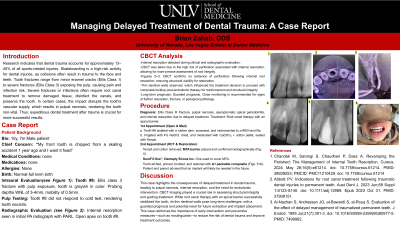Trauma
357 - Managing Delayed Treatment of Dental Trauma: A Case Report


Brian Zahab, DDS
Resident
University of Nevada, Las Vegas, NV
UNLV
Las Vegas, Nevada, United States- LR
Lee R. Roundy, Program Director, Pediatric Dentist
UNLV SDM Pediatric dental residency
Las Vegas, Nevada, United States
Presenting Author(s)
Program Director(s)
Introduction: Research indicates that dental trauma accounts for approximately 13–40% of all sports-related injuries. Skateboarding is a high-risk activity for dental injuries, as collisions often result in trauma to the face and teeth. Tooth fractures range from minor enamel cracks (Ellis Class 1) to severe fractures (Ellis Class 3) exposing the pulp, causing pain and infection risk. Severe fractures or infections often require root canal treatment to remove damaged tissue, disinfect the canals, and preserve the tooth. In certain cases, the impact disrupts the tooth's vascular supply, which results in pulpal necrosis, rendering the tooth non-vital. If left untreated, this condition can progress to internal resorption. Wearing helmets and mouthguards significantly reduces the risk of these injuries, while quick dental care after trauma is crucial for more successful results.
Case Report: This case report describes the management of an 11-year-old male patient who presented to the UNLV Dental School one year after sustaining a skateboarding injury that caused an Ellis Class III fracture with pulp exposure. The delayed treatment led to pulpal necrosis and internal resorption of the affected tooth. This report outlines the comprehensive management approach, including pulp vitality testing, CBCT imaging, root canal therapy with a mineral trioxide aggregate (MTA) barrier, composite restoration, and follow-up care. This report emphasizes the importance of early intervention in dental trauma cases and demonstrates the effectiveness of advanced diagnostic imaging, MTA barriers, and composite restorations in managing the complex outcomes associated with delayed treatment in pediatric dental injuries.
Identify Supporting Agency and Grant Number:

.jpg)